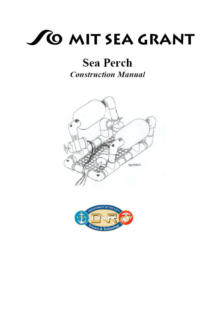Studies of ROV concepts 2010 - 2014





Date of publication: 2010
Authors: Bo Zhao, Mogens Blanke, Roger Skjetne
Abstract:
An integrated navigation system design is presented for
an underwater remotely operated vehicle (ROV).
The available navigation information is an acoustic
position measurement and a Doppler log speed
measurement. Both measurements are studied in detail
and modeled statistically. A kinematic model is assigned to
the ROV with its driving noise from a Gaussian mixture,
and a particle filter is suggested to
estimate ROV position and velocity.

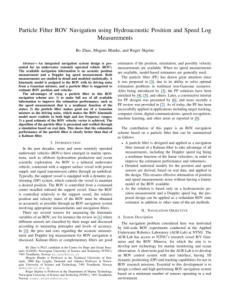

Date of publication: 2010
Authors: Marc Hildebrand, Leif Christensen, Jochen
Kerdels, Jan Albiez & Frank Kirchner
Abstract:
This paper presents a novel underwater movement
compensation algorithm for stabilization of manipulator
position utilizing not ROV movements for disturbance
compensation but overlaid manipulator movements. A
model-based estimator is used to predict vehicle
movement and provide the manipulation system with the
necessary time to compensate for the estimated motion.



Date of publication: 2010
Authors: Daniel Toal, Edin Omerdic, Gerard Dooly.
Abstract:
A Smart Remotely Operated Vehicle, ROV Latis designed
as a prototype test-bed for operation such as the
challenging role of ocean engineering support in wave
and tidal energy development, is presented in this paper.
With the state of the art navigation sensors/instruments,
the vehicle can achieve precision navigation and subsea
positioning. This capability has been utilized within
automatic control functionality, and autopilot control
systems developed and trialed on ROV Latis and not
available in commercial ocean ROV technology.

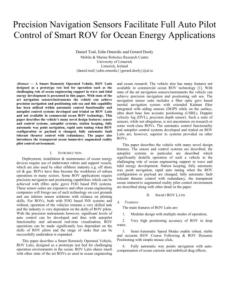

Date of publication: 2011
Authors: Alireza Marzbanrad, Jalil Sharafi, Mohammad
Eghtesad, Reza Kamali.
Abstract:
This report describes the design, construction, and control
of “Ariana-I”, an Underwater Remotely Operated Vehicle
(ROV), built in Shiraz University Robotic Lab. This ROV is
equipped with roll, pitch, heading, and depth sensors
which provide sufficient feedback signals to give the
system six degrees of freedom actuation.

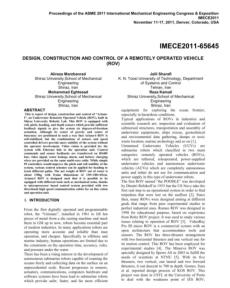

Date of publication: 2012
Authors: Franco Andaloro, Maria Ferraro, Edoardo
Mostarda, Teresa Romeo, & Pierpaolo Consoli.
Abstract:
The effectiveness of a remotely operated vehicle (ROV) to
describe the fish communities of three gas platforms
located offshore Crotone (Italy, Ionian Sea) was
investigated by comparing its observations with
underwater visual censuses (UVCs). The study was carried
out at two depth layers (0–6 and 12–18 m). Moreover,
the ROV was used to survey three deeper depth layers up
to 76 m.



Date of publication: 2012
Authors: O. Sulaiman, A.H. Saharuddin.
Abstract:
Remotely operated vehicles (ROVs) system requires
powerful vehicles to support the bollard thrust and tool
power required for deepwater tasks. Evolving deeper
waters, vehicle support for heavy-duty tasks demand,
deepwater subsea construction, repair, and maintenance
require an efficient ROV power pack to support these
tasks. Typical work-class ROV systems provide maximum
power levels ranging from 100 to 200 horsepower,
producing impressive thrust in
vertical or horizontal directions. The problem associated
with the ROV power pack includes inefficiencies in the
power system designs
that limit peak system performance thrust curves, the
inability of the hydraulic system to adjust to varying
demands, environmental concerns related to energy
usage, and ship husbandry. This paper addresses the
design and development of a variable pressure power
delivery and propulsion system that significantly increases
overall system efficiency to maximize the available power.



Date of publication: 2016
Authors: Daniel J. Brooksrov, Michael Lunderville, Holly
A.Yanco.
Abstract:
the authors introduce a simple modification that can be
applied to a commercial haptic device to convert it into a
2D haptic joystick. They also introduce a simplified haptic
API designed to allow the rapid development of
sophisticated haptic feedback behaviors on their 2D
joystick. Finally, they present a case study in which they
demonstrate the implementation of a haptic effect for
controlling an autonomous robot using their setup.

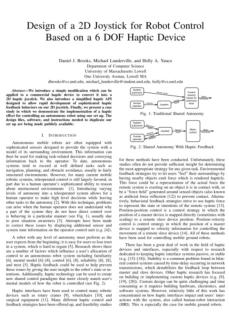

Date of publication: 2013
Authors:
Saeed Akram Malik, Pan Guang and Liu Yanan
This study describes a method useful for predicting the
hydrodynamic forces on a fully appended underwater
vehicle when operating beneath the free surface waves.



Date of publication: 2013
Authors:
Mohd Shahrieel Mohd Aras, Anuar Mohamed Kassim,
Alias Khamis, Shahrum Shah Abdullah, Muhammad Azhar
Abd Aziz.
This paper investigates the factor of tuning variable
parameters for single Input Fuzzy Logic Controller (SIFLC)
to improve the performance of depth control for
underwater Remotely Operated Vehicles (ROVs).

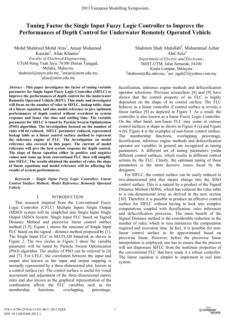

Date of publication:
Inventor: Harris O. Hinnant
This document is the patent file for an ROV navigation
system that comprises an underwater communication
network, at least one master controller node coupled to
the underwater communication network, at least one
network docking node connected to the underwater
communication network, and at least one submersible
vehicle for underwater mapping at least a portion of a
floor of a body of water. The vehicle comprises a
geolocation module to establish a geographic reference
for at least one location in the underwater geographic
region and an image collection module to collect images
of an underwater geographic area proximate to the
geographic reference.

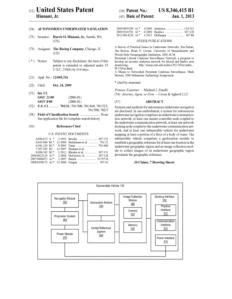

Authors:
Mohd Shahrieel Mohd Aras, Shahrum Shah Abdullah,
Azhan Ab. Rahman, and Muhammad Azhar Abd Aziz.
This paper describes a study of thruster modelling for
a remotely operated underwater vehicle (ROV) by
system identification using Microbox 2000/2000C.
Microbox 2000/2000C is an XPC target machine
device to interface between an ROV thruster with the
MATLAB 2009 software.
MATLAB is a programming and numeric computing
platform used by millions of engineers and scientists to
analyze data, develop algorithms, and create models.

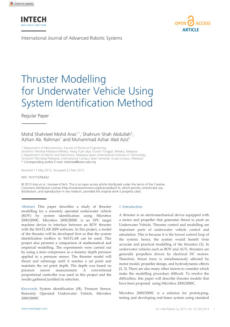

Authors:
Wallace M. Bessa, Max S. Dutra, and Edwin Kreuzer
The development of accurate control systems for
underwater robotic vehicles relies on the adequate
compensation of thruster dynamics. Without
compensation, the closed-loop positioning system can
exhibit limited cycles. This undesired behavior may
compromise the overall system stability. This work
proposes a fuzzy sliding-mode compensation scheme for
electrically actuated bladed thrusters, which are
commonly employed in the dynamic positioning of
underwater vehicles.



Date of publication: 2012
Authors: D. Obreja & L. Domnisoru
Abstract:
The present study focuses on the theoretical and
experimental hull resistance analysis of an underwater
ROV remotely operating vehicle, small in mass and
dimensions, used for maritime and offshore operations
survey at 30 m design depth.

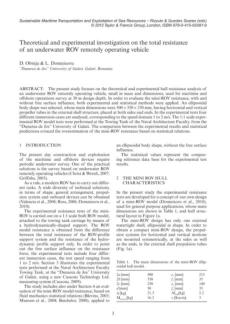

Authors: D. Obreja & L. Domnisoru
This study focuses on the theoretical and experimental hull
resistance analysis of an underwater ROV remotely
operating vehicle, small in mass and dimensions, used for
maritime and offshore operations survey at 30 m design
depth.

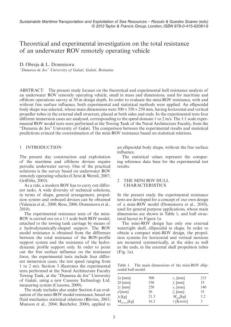

Authors: Jillian Chalke, Paul O'Brien, Christopher Conley,
Victor Puksta, Mustapha S. Fofana.
The use of professional scuba diving teams is an industry
practice for multiple commercial, environmental, and
military applications. Professional divers can be deployed
into dangerous conditions where surface communication
is often limited. In these situations, remotely operated
vehicles (ROVs) can improve communication and ensure
personnel safety and mission success. The objectives of the
MQP focus on designing and building a Dangerous
Inspection and Versatile Exploration Robot (DIVER)
capable of assisting, tracking, and monitoring professional
divers in commercial, military, and environmental research
applications.

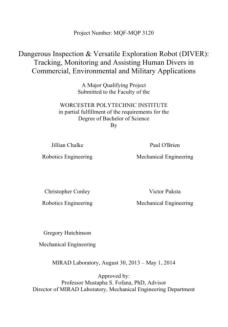


Date of publication: 2010
Authors:
Pedro J. Sanz, Pere Ridao, Gabriel Oliver, Claudio
Melchiorri, Giuseppe Casalino, Carlos Silvestre, Yvan
Petillot, Alessio Turetta
TRIDENT was a STREP project approved by the European
Commission, whose proposal was submitted to the ICT
call 4 of the 7th Framework Program. The project
proposed a new methodology
for multipurpose underwater intervention tasks. To that
end, a cooperative team formed with an Autonomous
Surface Craft and an Intervention Autonomous
Underwater Vehicle had to be used.

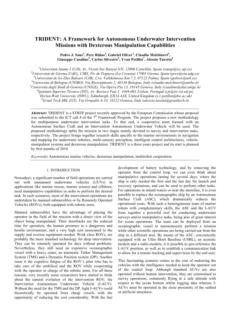

Date of publication: 2011
Authors: Yoong Hou Pin, Lin Boon Hoe, Kenneth Teo
Tze Kin, Ismail Saad
This paper uses the turning coefficient for the swimming
motion equation of a biomimetic fish robot. Based on the
Carangiform Wave, the swimming equation is cascaded
with the arc equation to change the oscillating axis during
turning movement (Chao Zhou). Usually, turning
movement is generated by defining the turning radius of
the arc equation to bend the Carangiform oscillating axis.
This involves the computation of turning radius power of
two and infinite radius value during straight movement.



Date of publication: 2012
Authors: Mathieu Porez, Vincent Lebastard, Auke Jan
Ijspeert, Frederic Boyer
This paper deals with the modeling of a fish-like robot
equipped with an electric sense, suited to study
sensorimotor loops. The proposed multi-physics model
merges a swimming dynamic model of a fish-like robot
with an electrical model of an embedded electrolocation
sensor. Based on a TCP-IP and threaded framework, the
resulting simulator works in real-time. This article also
focuses on numerical studies after presenting the
modeling aspects of this work.

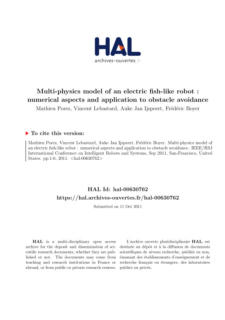

Authors:
Pedro J. Sanz, Pere Ridao, Gabriel Oliver, Giuseppe
Casalino, Carlos Insaurralde, Carlos Silvestre, Claudio
Melchiorri, and Alessio Turetta
ROVs usually are large and heavy vehicles that require
significant logistics for their transportation and handling.
Also, the complex user interfaces and control methods
require skilled pilots. These facts significantly increase the
cost of the application and justify the need for more
autonomous, cheap, and easy-to-use solutions for
underwater intervention missions, and this is the aim of
the current FP7-TRIDENT project.

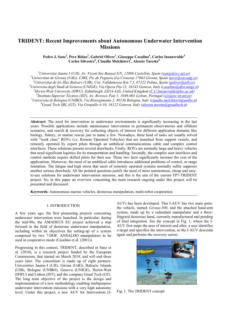

Date of publication:
Inventor: Morten Haugen
Remotely Operated Vehicles (ROVs) are common in deep-
water industries. Due to safety and practical reasons, it is
not convenient to use manned diving for maintenance
and surveys. The solution is to use ROVs that are
unmanned, highly maneuverable, and operated remotely
by a person on board a vessel. The ROV is normally
equipped with one or several manipulators so that it can
perform simple tasks such as pulling cables, opening
valves, and handling different tools.

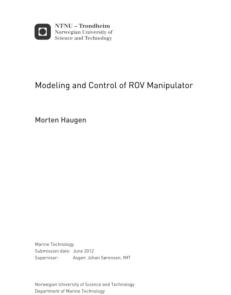

Authors:
Pedro J. Sanz, Pere Ridao, Gabriel Oliver, Giuseppe
Casalino, Yvan Petillot, Carlos Silvestre, Claudio Melchiorri,
Alessio Turetta
TRIDENT was the official acronym used for a funded
European project entitled: “Marine Robots and Dexterous
Manipulation for Enabling Autonomous Underwater
Multipurpose Intervention Missions”. This project
demonstrated a new approach for multipurpose
underwater intervention tasks with diverse potential
applications ranging from underwater archaeology and
oceanography to offshore industries.



Authors: Dylan K. Wainwright, Thomas,, Kleinteich,
Stanislav N. Sorry, and Adam P. Summers
The northern clingfish, Gobiesox maeandricus, can
adhere to slippery, fouled, and irregular surfaces in the
marine intertidal environment. This fish can adhere equally
well to surfaces with a broad range of surface roughness,
from the finest sandpaper (Ra =15 mm) to textures suitable
for removing finish from flooring (Ra = 269 mm). The fish
outperform man-made suction cups, which only adhere
to the smoothest surfaces. The adhesive forces of clingfish
correspond to pressures 0.2–0.5 atm below ambient and
are 80–230 times the body weight of the fish.

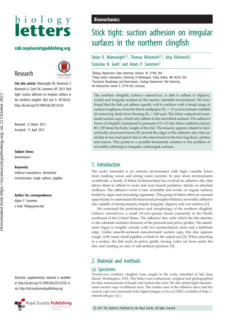

Date of publication: 2013
Authors: Francesca Tramacere, Lucia Beccai, Michael
Kuba, Alessandro Gozzi, Angelo Bifone,
Barbara Mazzolai
The octopus sucker represents a fascinating natural system
performing adhesion on different terrains and substrates.
Octopuses use suckers to anchor the body to the
substrate or to grasp, investigate and manipulate objects,
to mention a few of their functions. This study focuses on
the morphology and adhesion mechanism of suckers in
Octopus vulgaris. structure in O. vulgaris.

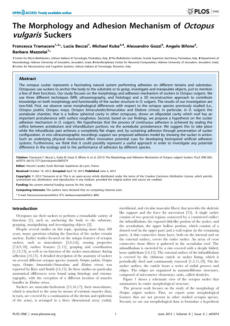

Date of publication: 2013
Authors: Curran Associates
These texts are the proceedings of a workshop held at
Toronto (Canada) on 7 July 2013

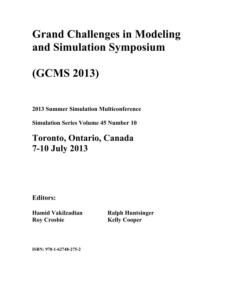

Authors: Afolayan Matthew Olatunde
Fishes are efficient swimmers, with teleost species known
for their high speed and acceleration inside water.
Imitating these abilities requires building an efficient
controller to manage the robotic fish system.
The efficiency is in terms of faster swimming ability while
consuming less energy as well as stable response to input
commands. The control scheme used for this work is
based on PIC18F4520 microcontroller, which generates
three rigidly coupled pulse width modulated (PWM)
signals that are used for controlling (in an open-loop
fashion) 3 Futaba RC servo motors manage the robotic
fish tail configurations dynamically.

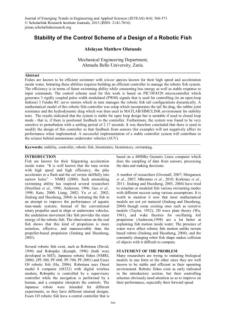

Date of publication: 2013
Authors: Andrea Arienti, Marcello Calisti, Francesco
Giorgio-Serchi, Cecilia Laschi
The design concept and development of a multipurpose
underwater robot is presented. The final robot consists of
a continuum composed of 80% of its volume of rubber-
like materials, and it combines locomotion (i.e., crawling
and swimming) and manipulation capabilities. The first
prototype of the robot is illustrated, based on the
integration of existing prototypes.

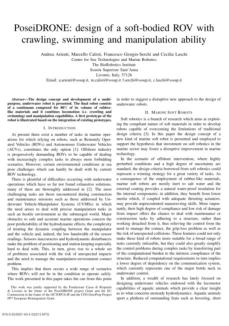

Date of publication: 2013
Authors: Izaak D. Neveln, Rahul Bale, Amneet Pal
Singh Bhalla, Oscar M. Curet, Neelesh A.
Patankar and Malcolm A. MacIver
While wake structures of many forms of swimming and
flying are well-characterized, the wake generated by a
freely swimming undulating fin has not yet been analyzed.
These elongated fins allow fish to achieve enhanced
agility, exemplified by the forward, backward, and vertical
swimming capabilities of knifefish, and also have potential
applications in the design of more maneuverable
underwater vehicles. The authors present the flow
structure of an undulating robotic fin model, using particle
image velocimetry to measure fluid velocity fields in the
wake.

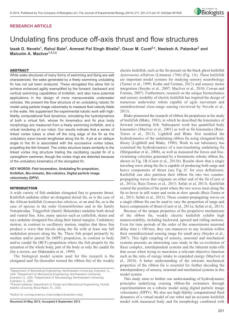

Date of publication: 2013
Authors: Petra Ditsche, Dylan K.) Wainwright, and
Adam P. Summers
Northern clingfish use a ventral suction disc to stick to
rough substrates in the intertidal zone. Bacteria, algae and
invertebrates row on these surfaces (fouling) and change
the surface properties of the primary substrate, and
therefore the attachment conditions for benthic
organisms. In this study, the authors investigate the
influence of fouling and surface roughness on the
adhesive strength of northern clingfish, Gobiesox
maeandricus. The authors measured clingfish tenacity on
unfouled and fouled substrates across four surface
roughnesses.

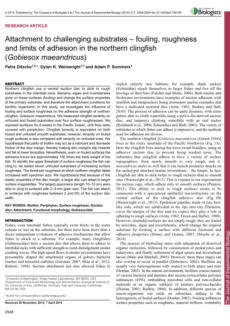

Date of publication: 2013
Authors: Francesca Tramacere, Alexander Kovalev,
Thomas Kleinteich, Stanislav N. Gorb and
Barbara Mazzolai
This study investigates the morphology and mechanical
features of Octopus vulgaris suckers, which may serve as a
model for the creation of a new generation of attachment
devices. Octopus suckers attach to a wide range of
substrates in wet conditions, including rough surfaces. This
amazing feature is made possible by the sucker’s tissues,
which are pliable to the substrate profile. Previous studies
have described a peculiar internal structure that plays a
fundamental role in the attachment and detachment
processes of the sucker.

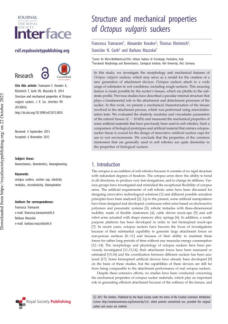

Date of publication: 2014
Authors: Andrew D. Marchese, Cagdas D. Onal, and
Daniela Rus
This document describes an autonomous soft-bodied
robot that is both self-contained and capable of rapid,
continuum-body motion. The authors detail the design,
modeling, fabrication, and control of the soft fish, focusing
on enabling the robot to perform rapid escape responses.
The robot employs a compliant body with embedded
actuators emulating the slender anatomical form of a fish.
In addition, the robot has a novel fluidic actuation system
that drives body motion and has all the subsystems of a
traditional robot onboard: power, actuation, processing,
and control.



Date of publication: 2014
Authors: Wisama Khalil, François Rongère
This paper presents the dynamic modeling of floating
systems with an application for a three-dimensional
swimming eel-like robot and owing-like system. The
dynamic models must be used to obtain the Cartesian
evolution during the design or control of these systems.
Owing to the complexity of such systems, efficient and
simple tools are needed to get their model. For this goal,
the authors propose an efficient recursive Newton-Euler
approach, which is easy to implement. It can be
programmed either numerically or using efficient,
customized symbolic techniques.



Date of publication: 2014
Authors: Mathieu Porez, Frederic Boyer, Ayman Belkhiri
This paper deals with the dynamic modeling of bio-
inspired robots with soft appendages, such as flying insect-
like or swimming fish-like robots. The authors propose
exploiting the Mobile Multibody System framework, in
which the robot is considered a tree-like structure of rigid
bodies whose joint evolution is governed by stress-strain
laws or control torques. Based on the Newton-Euler
formulation of these systems, the authors propose a new
algorithm to compute accelerations and the control
torques supplied by the motors. For illustrative purposes,
the proposed algorithm is applied to simulate the
hovering flight of a soft flapping-wing insect-like robot.



Date of publication: 2014
Authors: Francesca Tramacere, Esther Appel, Barbara
Mazzolai, and Stanislav N. Gorb
Octopus suckers are able to attach to any smooth surface
and many rough surfaces. The authors discovered that the
sucker surface, which has been hypothesized to be
responsible for sealing the orifice during adhesion, is not
smooth as previously assumed but is entirely covered by a
dense network of hair-like micro-outgrowths. This finding
is particularly important because it demonstrates the role
of hair structures in a sealing mechanism in water, similar
to that previously described for clingfish and abalones.

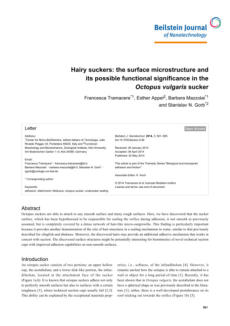

Date of publication: 2014
Authors: Frédéric Boyer, and Mathieu Porez
This article presents a set of generic tools for multibody
system dynamics devoted to studying bio-inspired
locomotion in robotics. Archetypal examples from the field
of bio-inspired robot locomotion are presented to prepare
the ground for further discussion. The general problem of
locomotion is then stated. In considering this problem, the
authors progressively draw a geometric picture of
locomotion dynamics.

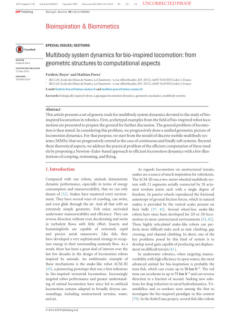

Date of publication: 2014
Authors: Pere Ridao, Marc Carreras, David Ribas, Pedro
J. Sanz, Gabriel Oliver
This paper reviews the evolution timeline in autonomous
underwater intervention systems. Milestone projects in the
state of the art are reviewed, highlighting their principal
contributions to the field. To the best of the authors'
knowledge, only three vehicles have demonstrated some
autonomous intervention capabilities so far: ALIVE,
SAUVIM, and GIRONA 500 I-AUV. Next, the GIRONA 500
I-AUV is presented, and its software architecture is
discussed.



Date of publication: 2014
Authors: Mathieu Porez, Frederic Boyer, Auke Ijspeert
The best-known analytical model of swimming was
originally developed by Lighthill and is known as large
amplitude elongated body theory (LAEBT). Recently, this
theory has been improved and adapted to robotics
through a series of studies, ranging from hydrodynamic
modeling to mobile multibody system dynamics. This
article marks a further step towards the Lighthill theory.
The LAEBT is applied to one of the best bio-inspired
swimming robots yet built: the AmphiBot III, a modular
anguilliform swimming robot.

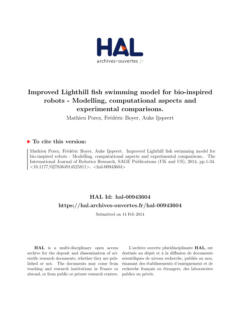



Click on the
octopus to return to
the top of the page



Authors: Kathryn Shroyer, Chryssostomos Chryssostomidis,
Rachel VanCott, Mike Soroka
This document aims to inform and promote the MIT Sea
Grant’s Sea Perch project, which introduces pre-college
students to underwater robotics. It highlights the
educational and collaborative aspects of the program,
which is part of a broader initiative by the Office of Naval
Research to recruit future naval architects, and suggests
ways in which the project can be integrated into a
multidisciplinary educational curriculum.

